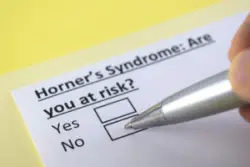
Horner’s syndrome occurs when the sympathetic nerves that connect the face and eyes with the brain suffer damage. This most commonly occurs in newborns when they suffer a neck and shoulder trauma during childbirth.
If your child has Horner’s syndrome because of a birth injury, you may be able to hold the doctor, hospital, or another liable party accountable. Call the Birth Injury Lawyers Group today at 1-800-222-9529. We can connect you with a Horner’s syndrome birth injury lawyer in your state.
Horner’s Syndrome Lawsuits and Injury Cases
If your baby suffered a birth injury and developed Horner’s syndrome, you may be able to pursue damages through a medical malpractice claim or lawsuit. While birth injuries can occur naturally because of the trauma of the birth process, a doctor or other practitioner can also cause birth injuries through medical negligence.
Medical care providers have a duty to follow proven protocols and provide an acceptable standard of care. If they fail to do so, the patients who suffer injuries and their families have a right to hold them liable. There are, however, deadlines on how long you have to pursue damages. A birth injury attorney from your state can explain this.
Proving Your Horner’s Syndrome Birth Injury Case
If your infant suffered neck or shoulder injuries during birth, causing Horner’s syndrome, the doctor delivering him may have used too much force or failed to follow proper protocols. An attorney can help you identify a medical expert witness who can testify to the acceptable standard of care in your case, and whether your doctor deviated from that standard of care during your baby’s delivery.
Your birth injury attorney will also help you document your full range of economic and noneconomic losses related to your child’s Horner’s syndrome. This may include medical bills, out-of-pocket costs, pain and suffering, mental anguish, and more.
Horner’s Syndrome Overview
Horner’s syndrome is a rare condition that causes constriction of the pupil, winking of the eyeball, drooping of the upper eyelid, and decreased sweating on the side of the face affected. It occurs when there is damage to the sympathetic nerves of the face. It typically affects only one side of the face.
Horner’s Syndrome Causes
There are a number of causes of Horner’s syndrome. While some people believe it can be congenital, most babies with the condition likely experienced birth injuries that included trauma to the neck or shoulder where the sympathetic nerves run from the spinal cord to the face.
Other causes may include:
- Brainstem strokes
- Injury to the carotid artery
- Tumors that affect the sympathetic nerves, often neuroblastoma
- Migraines or cluster headaches
- Demyelinating diseases
- Syringomyelia
- Arnold-Chiari malformation.
Horner’s Syndrome Symptoms
The symptoms of Horner’s syndrome usually only affect one side of the face and may include:
- A small pupil (miosis), leading to a difference in the size of the pupils (anisocoria)
- Drooping of the upper eyelid (ptosis)
- Sunken appearance to the eye
- Reduced or absent sweating on the affected side of the face (anhidrosis)
Horner’s Syndrome Diagnosis and Treatment
An ophthalmologist will perform tests, often using eye drops, to confirm the diagnosis. Your doctor may also want your child to undergo imaging scans to determine the location of the nerve injury or rule out other causes.
There is no treatment or cure for Horner’s syndrome caused by a birth injury. The symptoms may disappear once doctors address the underlying cause in other cases.
Horner’s Syndrome Frequently Asked Questions
How do I know if my baby has Horner’s syndrome?
If your baby has symptoms of Horner’s syndrome, you may want to consult a pediatrician familiar with the condition or schedule a visit with an ophthalmologist who can conduct diagnostic testing.
Can Horner’s syndrome be fatal?
Horner’s syndrome is not fatal, and your child can live a long, healthy life with a Horner’s syndrome diagnosis.
Who is liable for Horner’s syndrome?
If your child suffered a birth injury and this led to the development of Horner’s syndrome, you may be able to hold the doctor who delivered your baby or the hospital where he was born liable for his birth injuries.
What is the statute of limitations for Horner’s syndrome?
How long you have to take legal action against the medical care provider or facility who caused your child’s birth injury varies by state. Each state has its own statute of limitations for medical malpractice claims. Many states extend this deadline when the victim is a minor, known as “tolling.”
Some states, however, have a statute of repose that sets an absolute deadline for filing this type of legal case. An attorney from your state can offer advice specific to your case.
Horner’s Syndrome Glossary Terms
- What is miosis? Miosis is when the pupil of the eye is very small. Bright lights most often cause it. Those with Horner’s syndrome have chronic miosis caused by nerve damage.
- What is Anisocoria? Anisocoria is decreased or absent sweating. Children with Horner’s syndrome often have anisocoria on the affected side of the face.
- What is Ptosis? Ptosis is a drooping of the eyelid characteristic of Horner’s syndrome and other conditions that affect the sympathetic nerves.
Talk to a Horner’s Syndrome Birth Injury Lawyer in Your State Today
If your baby sustained an injury during birth and developed the symptoms of Horner’s syndrome, the Birth Injury Lawyers Group can help. We can connect you with an attorney in your state who can review your case at no cost to you. You may be able to take legal action to hold the doctor or hospital who caused your infant’s injuries liable.
Call 1-800-222-9529 today to discuss your case with a birth injury attorney at no out-of-pocket cost to your family.

